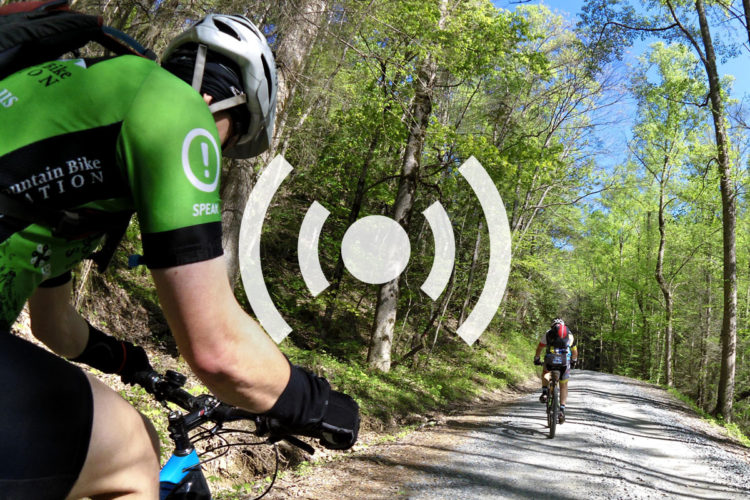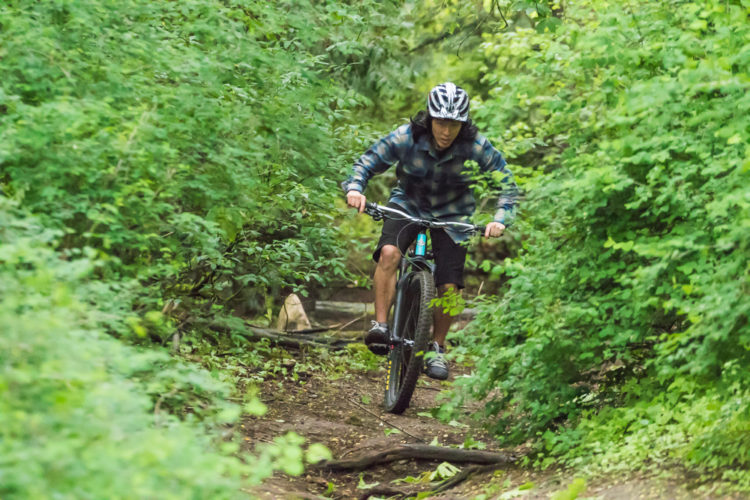
Two time New Zealand National Downhill champion Kate Weatherly started off her 2019 gravity season with a blazing fire underneath her. She earned a second place finish at Crankworx Rotorua, sixth place at the UCI World Cup in Fort William, and a third place podium in Leogang. Weatherly’s run in Austria marks her first career appearance on the World Cup podium stage, and we recently chatted with her to find out what it felt like to spray that dreamy champagne.
Kate races as a privateer, works on her own bikes, tunes her own suspension, and funds her season with savings from her bike mechanic gig back home and help from her family. It’s equally rare and impressive when privateer racers earn a spot on the podium at the highest level of racing, alongside competitors who have a full staff of folks taking care of their bikes, travel logistics, massage schedules, and other life tasks.
In addition to the full-time job of managing her entire race program, Weatherly has been bullied throughout her career by people who disagree with or dislike the fact that she races in the elite women’s category as a transgender woman. She has dealt with transphobic comments and threats with bravery and grace, but there is no doubt that it affects her ability to feel welcome or supported by the elite gravity community.
Weatherly began taking hormone blockers and estrogen three years prior to racing in a women’s event and she has met each of the IOC and UCI regulations for a transgender athlete to compete in elite level women’s events. Unfortunately, some folks in the mountain bike industry and community are taking their frustration with those regulations out on her, rather than the governing bodies that created them.
Read on for Weatherly’s thoughts on the bullying she has endured in the second half of our interview.

Which races remain on your 2019 calendar, and has that changed with your recent success at the last two World Cup rounds?
For this season I am planning on doing all the European World Cup rounds and then the World Champs in Canada. Currently, I’m not planning on doing the final round in Snowshoe as its too far/expensive for me. My recent results haven’t changed my goals or my race plans, just helped pay for things and given me the fire to push harder.
Have you been able to find the sponsorship and career opportunities you need to make the World Cup travel possible?
Currently, I am supported by a few small wholesale companies back home in New Zealand who do their best to help me but they simply don’t have the money to do much. Prize money from events goes a long way but honestly my ability to race is down to support from family and work. I’m hoping to find more support for next year as it’s difficult to race at this level with only the support of a small team back home.
How do you feel that your new training plan has helped you earn your results so far this season?
It’s always hard knowing if training has paid off, you train and train but it’s hard to know until the clock starts. I really knew the training I’ve done with Fit4Racing had paid off during my qualification and finals runs in Fort William when even after 4 minutes of racing I was still able to sprint hard on the final motorway section. It made a huge difference, and this year I feel that it’s my skill limiting my speed rather than my fitness or strength, which was the case last year, which is how it should be.
[see_also id=’261661′]

For Fort William, what are some of the skills that helped you ride so well on that treacherous track? What can readers do to ride faster in the rain?
Fort William was a wild track, far from the steepest on the circuit but still very difficult and rough. I found the best way to go fast there was to not try to “ride” the bike too much, and rather than being too aggressive, use the terrain to give you speed and not waste energy. The track is so long, being smooth and not wasting energy makes a massive difference. Even though it rained pretty much the whole weekend the track mostly held up very well. In the few slippery sections, I found the best way to stay upright was to keep light on the bike and let it do what it wants and not try and force the bike (this is especially true of the ruts that had formed into the road gap).
Leogang is a true downhiller’s track, and this year’s course looked to be one that put everyone on the edge of traction. Did you have any close calls on your podium-placing run?
My run in Leogang was ironically far from a perfect run. I had a big mistake in the new stump section before the motorway and messed up my line, as a result. I pushed very hard on the motorway to make up for it, and then I had another mistake in the new section in the forest. I was lucky as it [didn’t lose] me much time but the track definitely punished mistakes. The grip was very low on the dusty and dry track and I found that keeping light through corners and, like Fort William, finding where I could push and pushing in those [sections] and then taking it easy in the more difficult sections.
What were some of the most difficult bits of the track in Leogang?
For Leogang ironically I struggled most in all the tight flat corners, it’s an area I am aware [that] I struggle with and I need to focus on more. I struggle to make sure to counterweight my hands to lean the bike into the corner and this track was full of them, which is good as it forced me to focus on a skill I lack but it also punished that lack of skill. It’s something I plan to work hard on before Andorra.

You had a blistering pace on the jumps at the top of the track in Leogang. Do you have advice for readers about carrying higher speed through big jumps?
Carrying speed on jumps is hard, often people assume going in as fast as possible is the way to go, however, I found that pedaling in fast and then either squashing (absorbing the lip) of the jump, or a slight brake check, allowed me to get the perfect downslope and get better exit speed. Jumps [can] seem just like max speed is better, in and out of the jump, however, a jump is like a corner or any technical section, exit speed is always the most important thing. There was almost no time to pedal on the bottom half of the motorway and getting that fast exit speed allowed me to have the fastest speed in the speed trap (right before the two large wall rides).
What did it feel like to sit in the WC hot seat?
I was honestly so surprised when rider after rider came down and didn’t beat my time. I knew my run was good but I didn’t realize how good. I was beyond stoked for it, and Nina getting her result, and Tracey has been an idol of mine for years and seeing her get another win for the first time in a few years was amazing. I was really gutted for Marine after she crashed on such a good run but I guess that’s racing. It was very surreal and I honestly still haven’t really processed it.
How are the transphobic comments that folks are posting on social media (and elsewhere) making you feel? Are they affecting your racing, or are you able to shut them out?
Its really hard having to jump through all the hoops set by the UCI to be able to compete and [then to] have people call into question my place at the World Cup, as well… After working so hard for so long, when people assume my results are down to how I was born not how hard I train is pretty hard, spending hours in the gym and on the bike and having that kind of dismissal is really hard. I can move on but it does get overwhelming sometimes.

What would you like the racing community to understand about you as an elite athlete, who happens to be transgender? Is there something folks are confused about or afraid of that you would like to share some thoughts or information on?
People seem to think that trans women are essentially men competing with women [and that] is about as far from the truth as possible. I mean, for the most part, trans women were never very masculine as they often have always been drawn to feminine things. In my case, I started puberty late and never really had male puberty. Trans women may not be exactly the same as the average cis-gender woman but not every cis woman is the same. There is so much variation you can’t really compare people, but the truth is in the evidence. I’m not beating the field by some crazy margin, I get beaten very regularly and my results may seem sudden but I’ve been transitioning for years, far longer than I’ve been racing world cups, and my results have slowly been improving, this isn’t my first season, and no one seemed to care when I got 12th and 10th last year.
Trans women may not be exactly the same as the average cis-gender woman but not every cis woman is the same.
Do you think that the rules and regulations that the UCI/IOC has established around transgender athletes are fair and reasonable? If not, what do you feel should be done differently?
I think the IOC/UCI rules were created quickly to fit the needs of the 2016 Olympics and do need development (which as I understand is the case). [The issue is] mainly that the testosterone limit is 10 n/mol while the average levels among cis women are around 0.4-2.5 n/mol. The levels required by the IOC should be dropped. This is however not an issue for any trans woman as for us to properly transition we need essentially no testosterone, I have mine checked every 3 months and the highest its been since May of 2016 has been 1.4 n/mol and my average result is 0.6, far from the current limit.

I imagine that you have received a lot of messages from inspired fans. Can you share one or two that really stood out for you?
The one plus side from the more public outcry against my racing is that there has been even more support. One of the most amazing people has been ex downhill pro Amanda Batty. She took the time to do her own research without any pre-existing biases and she has been very vocally supportive, I can’t quite repeat her very ‘passionate’ comments but she is amazing and has been very validating of my situation.
Beyond that many people have sent me messages of support. One case that has touched my heart the most was a family based out of Christchurch back home in NZ who have a young (9-year-old) transgender child and my racing has given them hope that she can do whatever she wants in the future. [This] is why I do what I do really, so people like her don’t have to give up on dreams because uneducated people think they know what they’re talking about, and [they] crush the dreams of trans athletes.

You can keep up with Weatherly’s 2019 gravity storm via her social media channels, and watch her race the next World Cup in Andora on the 6th of July, live on Redbull.tv.




















0 Comments